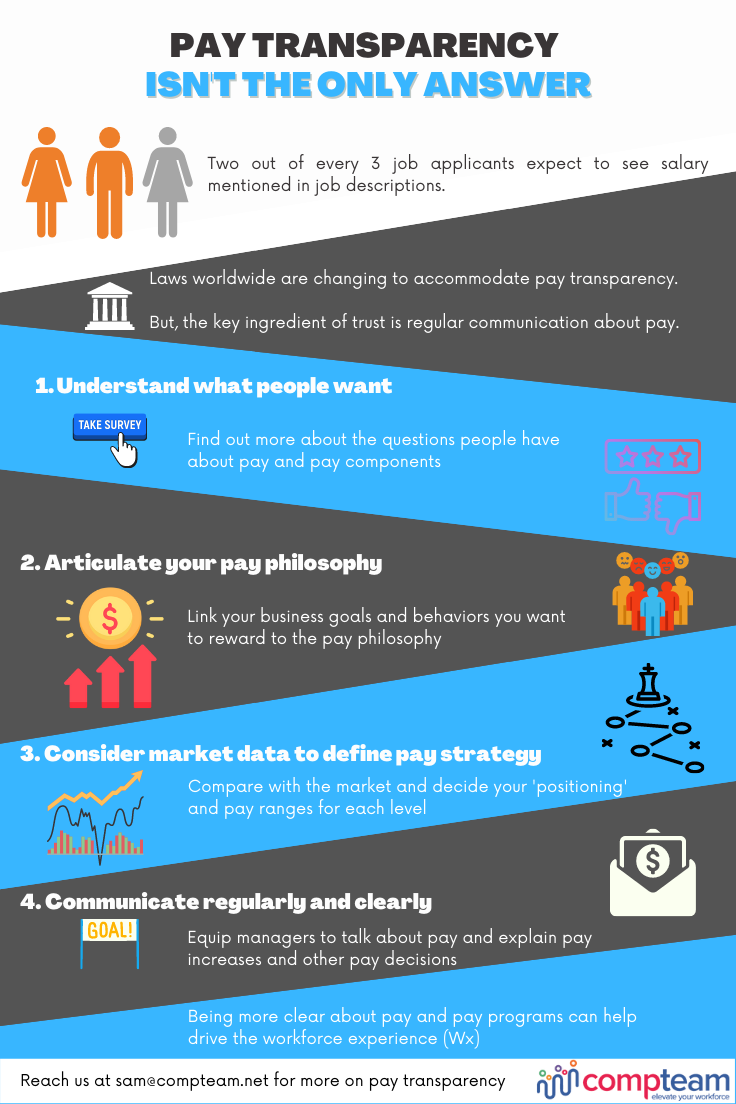Why Pay Transparency isn’t the Only Answer
Nearly two out of every three job seekers expect to see the salary mentioned in job descriptions. Apart from job applicants, governments are also wading into the pay transparency debate. Laws around the world are changing to accommodate pay ranges or hourly rates. As a result, more and more companies are feeling the pressure to do something that makes pay more transparent and better understood
But, does pay transparency have to be ‘all or nothing’?
Two companies offering the same hourly rate or similar pay ranges might still have drastically different ‘total rewards’ –the sum total of all base pay, variable pay, and benefits combined. As a result, without additional context, the difference in the monetary offer may not be visible to a job applicant. Even existing employees may feel confused about what the pay components mean. Therefore, being transparent about pay does not have to be a binary yes-or-no scenario. Educating people about how pay works is a key ingredient that supports the workforce experience (Wx).
How should you address the question of pay transparency?
The bedrock of a great Wx is trust and psychological safety. Does your workforce believe you are fair, equitable, and trustworthy? Publishing everyone’s salaries in the public domain, like Buffer, may be an extreme step that you are not ready for (yet). However, there are some steps you can take to ensure that people feel comfortable with the way pay is managed.
However, there are some steps you can take to ensure that people feel comfortable with the way pay is managed.
1.) Know what people want: What are some of the most burning questions people have around pay and benefits? Do they understand the various pay components well enough and what are the gaps they would like addressed?
2.) Articulate your pay philosophy: Based on your business goals and the behaviors you want to reward, create a pay philosophy guide. You can share an overview of your philosophy on your career page and a more detailed version internally for people.
Some of the aspects to be added to the pay philosophy would be:
•What results/behaviors do you want to reward?
•Do you rely more on internal promotions or on the outside market?
•What kind of unique challenges exist for certain roles or locations in hiring?
3.) Consider market data to define pay strategy: Define your job descriptions accurately and by comparing with the market for similar jobs, decide on your pay positioning and design the pay ranges.
The pay positioning will clarify at what percentile of the market you would like to pay. It can be a consistent strategy or differentiated based on role complexity, talent supply, or location.

4.) Continue communicating: Letting people know about your pay philosophy can lead to more clarity about performance goals. People would know how their pay is decided and what they are expected to do to reach the next pay increase. Considering that nearly 60% of organizations don’t train managers on communicating about pay, the simplest way to get ahead of the curve is to start doing this.
Conclusion
For more ideas on pay transparency, reach out to us at [email protected]
About the Author
Sumit Single
Sumit has been working in HR & HR consulting roles for 16+ years across sectors and verticals and specializes in organizational design, well-being, storytelling & design thinking, and performance management. In his career with consulting firms such as Aon, Deloitte, and Accenture, he has successfully led programs aimed at total HR transformation for clients.
As Associate Director for India Consulting at Deloitte, he recently worked with clients on cultural transformation, HR processes, and policy design. He also organized and spoke at conferences and events about various topics relevant to HR today.
Now self-employed, he works with clients across the globe on various HR solution areas.
Sam Reeve
Sam Reeve, CompTeam founder and managing consultant, is a pay and talent performance expert and a certified global compensation professional. His extensive experience with pay programs and competitive compensation analysis, career architecture, and talent management allows him to help clients of rapidly growing firms see accurate, measurable results, including increased productivity and significant pay savings, year-over-year.
As an innovative thinker with practical application, Sam strongly believes that everyone needs to be healthy and happy in their own lives to strive as a high-performing contributor. He is driven to help organizations match their employees with the work they are passionate about and reward their people for outstanding work.






